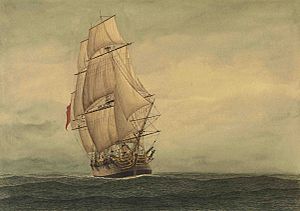First Fleet facts for kids
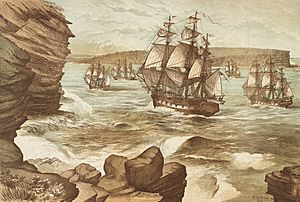
The First Fleet was a group of 11 British ships that brought the first British settlers and convicts to Australia. It included two Royal Navy ships, three supply ships, and six ships for carrying convicts. On May 13, 1787, the fleet, led by Captain Arthur Phillip, left Portsmouth, England. More than 1,400 people were on board, including convicts, marines, sailors, government workers, and free settlers. They traveled over 24,000 kilometres (15,000 mi) for more than 250 days. Their goal was to reach Botany Bay, New South Wales, where they would start the first British settlement in Australia.
Contents
History of the First Fleet
The idea to start a British colony in Botany Bay, New South Wales, was supported by Lord Sandwich and Sir Joseph Banks. Banks was a famous scientist who had sailed with Lieutenant James Cook on his 1770 voyage.
The decision to create a colony in Australia was made by Lord Sydney, who was a government minister. There were two main reasons for this:
- Britain could no longer send criminals to North America after the American Revolution.
- Britain needed a base in the Pacific to compete with France.
In September 1786, Captain Arthur Phillip was chosen to lead the fleet. He was to transport the convicts and soldiers to start the colony at Botany Bay. Once they arrived, Phillip would become the Governor of the new colony. A smaller colony was also planned for Norfolk Island. This island had native flax and timber that could be useful for the navy.
The cost for Britain to prepare and send the fleet was about £84,000. This would be around £9.6 million (or $19.6 million) today.
Ships of the Fleet
The First Fleet was made up of 11 ships. These included two Royal Navy ships for protection, six ships to carry convicts, and three ships for supplies and food.
On October 25, 1786, HMS Sirius was prepared for the journey, with Captain Phillip in command. The smaller ship HMS Supply also joined the expedition. Captain John Hunter was assigned as the second captain of Sirius.
| Ship | Type | Master | Crew, Officials, Marines | From | Arrived Botany Bay |
Duration (days) |
|---|---|---|---|---|---|---|
| HMS Sirius | 10 gun | John Hunter | 200 | Portsmouth | January 20, 1788 | 252 |
| HMS Supply | Armed tender | Henry Lidgbird Ball | 55 + 2 (convicts transferred on route) | Spithead | January 18, 1788 | 250 |
HMS Sirius
Sirius was Captain Phillip’s main ship for the fleet. It was a 520-ton ship that had been changed from a merchant ship. It was armed with ten guns, but Phillip added ten more.
HMS Supply
Supply was a smaller, 170-ton ship. It was originally used to carry naval supplies. It had four small cannons and six swivel guns. More cannons were added in 1786.
Convict Transport Ships
These ships carried the convicts to Australia.
| Ship | Type | Master | Crew | Marines | Arrived Botany Bay |
Duration (days) |
Convicts Arrived (Boarded) | |
|---|---|---|---|---|---|---|---|---|
| Males | Females | |||||||
| Alexander | Barque | Duncan Sinclair | 30 | 41 | January 19, 1788 | 251 | 210 Two were pardoned |
0 |
| Charlotte | Transport | Thomas Gilbert | 30 | 32 | January 20, 1788 | 252 | 100 | 24 |
| Friendship | Brig | Francis Walton | 25 | 42 | January 19, 1788 | 251 | 80 | 24 To Cape of Good Hope only, transferred to Lady Penrhyn |
| Lady Penrhyn | Transport | William Cropton Server | 30 | 18 | January 20, 1788 | 252 | 0 | 101 |
| Prince of Wales | Barque | John Mason | 29 | 45 | January 20, 1788 | 252 | 2 | 47 |
| Scarborough | Transport | John Marshall | 30 | 50 | January 19, 1788 | 251 | 208 | 0 |
Food and Supply Ships
These ships carried important items like tools, farm equipment, seeds, medical supplies, and even a wooden frame for the first Government House. The settlers needed these supplies to survive until they could grow their own food.
| Ship | Type | Master | Crew | Arr. Botany Bay | Duration (days) |
|---|---|---|---|---|---|
| Golden Grove | storeship | William Sharp | 22 | January 20, 1788 | 252 |
| Fishburn | storeship | Robert Brown | 22 | January 20, 1788 | 252 |
| Borrowdale | storeship | Hobson Reed | 22 | January 20, 1788 | 252 |
Golden Grove
The chaplain for the colony, Reverend Richard Johnson, traveled on the Golden Grove with his wife and servants.
Legacy of the Ships
You can see scale models of all the First Fleet ships at the Museum of Sydney. These models were carefully built by Lynne and Laurie Hadley, who studied the original plans.
Nine Sydney Harbour ferries built in the 1980s are named after First Fleet vessels.
People of the First Fleet
Most of the people on the First Fleet were convicts. They had been tried and found guilty in Great Britain, mostly in England. Many had come from other parts of Britain or from Ireland. Some were from British colonies in North America, and 12 were identified as black. The convicts had committed various crimes, mainly theft. Their death sentences were often changed to penal transportation, meaning they were sent away for 7, 14 years, or for life.
Four groups of marines volunteered to serve in the new colony. These marines formed the New South Wales Marine Corps, led by Major Robert Ross. There was a group of marines on each convict ship, and their families also made the long journey.
Many people on the First Fleet kept diaries and journals. These include surgeons, sailors, officers, and soldiers. There are at least eleven known journals and some letters that tell us about their experiences.
The exact number of people on the First Fleet is not perfectly known because records vary slightly. About 1,420 people are believed to have started the journey in 1787, and 1,373 are thought to have landed at Sydney Cove in January 1788.
Here are some numbers from Mollie Gillen's book about the First Fleet:
| Embarked at Portsmouth | Landed at Sydney Cove | |
|---|---|---|
| Officials and passengers | 15 | 14 |
| Ships' crews | 323 | 306 |
| Marines | 247 | 245 |
| Marines' wives and children | 46 | 45 + 9 born |
| Convicts (men) | 582 | 543 |
| Convicts (women) | 193 | 189 |
| Convicts' children | 14 | 11 + 11 born |
| Total | 1,420 | 1,373 |
Governor Phillip reported the non-Indigenous population of the colony in 1788 as 1,030. The colony also had 7 horses, 29 sheep, 74 pigs, 6 rabbits, and 7 cattle.
The chief surgeon, John White, reported 48 deaths and 28 births during the voyage.
Notable Members of the First Fleet
Officials
- Captain Arthur Phillip, R.N, Governor of New South Wales
- Major Robert Ross, Lieutenant Governor and leader of the marines
- Captain David Collins, Judge Advocate (a legal officer)
- John White, Principal Surgeon
- Richard Johnson, chaplain
Soldiers
- Lieutenant George Johnston
- Captain Watkin Tench
- Lieutenant William Dawes
Sailors
- Captain John Hunter, commander of HMS Sirius
- Lieutenant Henry Lidgbird Ball, commander of HMS Supply
- Lieutenant William Bradley, 1st lieutenant of HMS Sirius
- Lieutenant Philip Gidley King, leader of Norfolk Island
- Arthur Bowes Smyth, ship’s surgeon on Lady Penrhyn
Convicts
- Mary Bryant, who famously escaped the colony with her family and others and returned to England.
- Henry Kable, who became a businessman.
- James Martin, who wrote about his escape with Mary Bryant.
- James Ruse, one of the few farmers in the colony at the start.
- Robert Sidaway, a baker who opened the first theater in Sydney.
- James Squire, a brewer.
The Voyage to Australia
Preparing the Fleet
In September 1786, Captain Arthur Phillip was chosen to lead the journey to set up a colony in New South Wales. On December 15, Captain John Hunter was appointed Phillip’s second-in-command. HMS Sirius was chosen as the main ship, with Hunter in charge. The smaller ship HMS Supply also joined the fleet.
While Phillip was in London, Lieutenant John Shortland oversaw the loading of the ships.
By March 16, 1787, the fleet began to gather at Motherbank, Isle of Wight. On May 9, Captain Phillip arrived in Portsmouth and gave the final orders for departure.
Leaving Portsmouth
The fleet finally left Portsmouth, England, on May 13, 1787. The journey started with good weather, and convicts were allowed on deck. On June 3, 1787, the fleet stopped at Santa Cruz in Tenerife to get fresh water, vegetables, and meat. On June 10, they sailed towards Rio de Janeiro, using the helpful trade winds.
As they sailed through the tropics, the weather became very hot and humid. Pests like rats, bedbugs, and fleas bothered everyone. The ships' lower areas became smelly, especially where convicts were kept. Although Phillip ordered daily cleaning, this was not always done on Alexander, and some convicts became sick and died. Tropical rainstorms meant convicts couldn't exercise on deck, as they had no dry clothes. Water was rationed to three pints a day.
The Fleet reached Rio de Janeiro on August 5 and stayed for a month. The ships were cleaned, and large amounts of food were bought. The women convicts' clothes were burned because of lice, and they were given new clothes made from rice sacks.
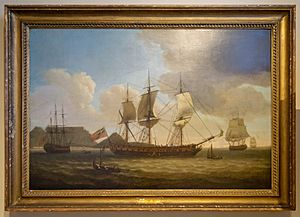
The Fleet left Rio de Janeiro on September 4 and sailed to Table Bay in southern Africa, arriving on October 13. This was their last stop before Australia. They stocked up on plants, seeds, and livestock for the new colony. This included two bulls, seven cows, one stallion, three mares, 44 sheep, 32 pigs, four goats, and many kinds of poultry. Convicts were given fresh food to build their strength. Cape Town was the last European settlement they would see for a long time.
Helped by strong winds in the "Roaring Forties" (south of 40 degrees latitude), the ships moved quickly through rough seas. In the last two months, the fleet faced difficult conditions. Water supplies ran low, and other goods like wine ran out on some ships. Van Diemen's Land (now Tasmania) was seen on January 4, 1788. A storm hit as they sailed north around the island, damaging some ships.
On November 25, Phillip moved to Supply. He sent Supply and the fastest convict ships (Alexander, Friendship, and Scarborough) ahead. Phillip hoped to find a good spot, fresh water, and start building before the others arrived. However, this "flying squadron" reached Botany Bay only hours before the rest of the fleet. So, no preparation was possible. Supply arrived on January 18, 1788; the three fast transports arrived on January 19; and the slower ships, including Sirius, arrived on January 20.
This was one of the world's greatest sea voyages. Eleven ships carrying about 1,487 people and supplies traveled for 252 days, covering more than 15,000 miles (24,000 km), without losing a single ship. Forty-eight people died on the journey, which was a low death rate of just over three percent.
Arrival in Australia
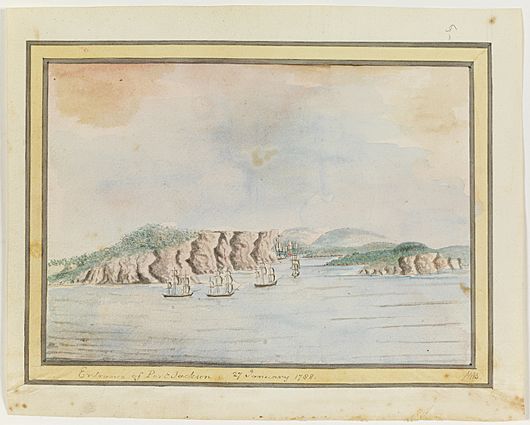
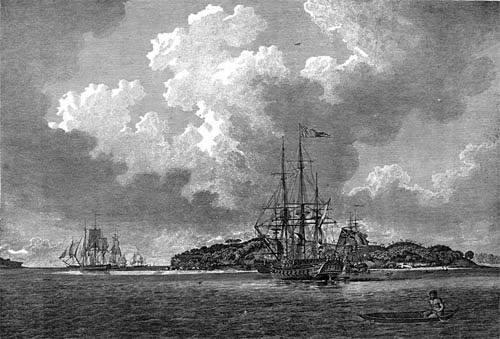
It was soon clear that Botany Bay was not as good as explorer Captain James Cook had described. The bay was open and not protected, the water was too shallow for ships to anchor close to shore, fresh water was scarce, and the soil was poor. The British had their first contact with the local Eora people, who were curious but seemed suspicious. The area had very strong trees that were hard to cut down. The first huts built for officers fell apart in rainstorms. Phillip was also worried about attacks from "Aborigines" or other countries. Even though his first orders were to settle at Botany Bay, he was allowed to choose another location if needed.
On January 21, Phillip and a group, including John Hunter, explored other bays to the north in small boats. Phillip found that Port Jackson, about 12 kilometers north, was an excellent place for a colony. It had sheltered anchorages, fresh water, and fertile soil. Cook had seen and named this harbor but had not entered it. Phillip wrote later that it was "the finest harbour in the world." The group returned to Botany Bay on January 23.
On the morning of January 24, two French ships, the Astrolabe and the Boussole, appeared outside Botany Bay. This was a scientific expedition led by Jean-François de La Pérouse. The French had expected to find a busy colony where they could repair ships, not a new fleet of convicts. There was friendly contact between the French and British officers, but Phillip and La Pérouse never met. The French ships stayed until March 10 before sailing away. They were later shipwrecked off the coast of Vanikoro in the Solomon Islands.
On January 26, 1788, the Fleet sailed to Port Jackson. The chosen spot for anchoring had deep water close to shore, was sheltered, and had a small stream. Phillip named it Sydney Cove, after Lord Sydney. This date is now celebrated as Australia Day, marking the start of British settlement. The British flag was not officially planted until February 7, 1788, when possession was formally declared. A British naval flag had been put up on the evening of January 25, 1788, by Phillip and some officers from Supply. The rest of the Fleet arrived at Sydney Cove later that day.
First Contact with Indigenous Australians
The First Fleet met Indigenous Australians when they landed at Botany Bay. The Cadigal people of the area saw the Fleet arrive. When the Fleet moved to Sydney Cove, they met the Eora people, including the Bidjigal clan. Many First Fleet journals describe these meetings.
The British government wanted friendly relations with Aboriginal people, and Arthur Phillip ordered them to be treated well. However, conflict soon began. The colonists did not sign treaties with the original inhabitants. Between 1790 and 1810, Pemulwuy of the Bidjigal clan led attacks against the colonists.
After January 1788
Most of the First Fleet ships did not stay in the colony. Some returned to England, while others sailed to different ports. A few ships stayed to help the Governor for some months. Some of these were sent to Norfolk Island to help set up a second penal colony.
- February 15, 1788 – HMS Supply sails for Norfolk Island to start a settlement.
- May 5/6, 1788 – Charlotte, Lady Penrhyn, and Scarborough sail for China.
- July 14, 1788 – Borrowdale, Alexander, Friendship, and Prince of Wales sail back to England.
- October 2, 1788 – Golden Grove sails for Norfolk Island with convicts, returning to Port Jackson on November 10. HMS Sirius sails for Cape of Good Hope for supplies.
- November 19, 1788 – Fishburn and Golden Grove sail for England. Only HMS Supply remains in Sydney Cove.
- December 23, 1789 – HMS Guardian, carrying supplies, hits an iceberg and cannot reach the colony.
- March 19, 1790 – HMS Sirius is wrecked off Norfolk Island.
- April 17, 1790 – HMS Supply is sent to Batavia, Dutch East Indies, for emergency food.
- June 3, 1790 – Lady Juliana, the first ship of the Second Fleet, arrives in Sydney Cove.
Legacy of the First Fleet
Last Survivors
In 1842, a newspaper reported that the government would give a small pension to the last survivors of the First Fleet. However, this turned out to be false. At least 25 people who arrived with the First Fleet were still alive then, including some children born during the voyage.
Some of the last known survivors of the First Fleet include:
- Henry Kable: a convict who died in 1846, aged 84.
- John Limeburner: a convict who died in 1847, said to be 104 years old. He helped set up the first tent in Sydney.
- John Small: a convict who died in 1850, aged 90.
- Elizabeth Thackery: a convict who died in 1856, aged 89. She is buried next to her husband, Samuel King, another First Fleeter.
Smallpox and its Impact
Historians have different ideas about whether the First Fleet caused the smallpox epidemic among Australia's Indigenous population in 1789.
One idea is that smallpox arrived with the First Fleet. Some researchers have suggested it might have been released on purpose, perhaps as revenge or to clear land for the colony. Others believe it might have been accidental, perhaps from smallpox material brought for vaccinations.
Another theory is that smallpox came from fishermen from Makassar in Indonesia, where the disease was common. It might have spread across the continent before the First Fleet arrived.
A fourth idea is that the 1789 epidemic was not smallpox but chickenpox. Indigenous Australians had no natural protection against chickenpox either.
Commemoration Garden

A stonemason named Ray Collins spent years researching the First Fleet. He wanted to build a garden to remember these first immigrants. The Liverpool Plains Shire Council agreed to let him build it for free in Wallabadah, New South Wales. Collins carved the names of all the people who came on the 11 ships in 1788 onto stone tablets. The garden tells the stories of their lives and their first encounters with Australia. The First Fleet Garden opened on January 26, 2005, as a major memorial.
First Fleet Park
First Fleet Park is in The Rocks, close to where the First Fleet first landed. This area has always been public land since 1788. It was once used for a hospital, shops, and the first post office. You can still find archaeological remains from the earliest days of the settlement there.
Fiction about the First Fleet
- James Talbot, The Thief Fleet, 2012
- Colleen McCullough, Morgan's Run
- Timberlake Wertenbaker, Our Country's Good
- Thomas Keneally, The Playmaker
- Marcus Clarke, For the Term of his Natural Life. Melbourne, 1874
See also
 In Spanish: Primera Flota para niños
In Spanish: Primera Flota para niños
- Australian frontier wars
- Convicts in Australia
- History of Australia (1788–1850)
- History of Indigenous Australians
- Journals of the First Fleet
- Penal transportation
- Second Fleet (Australia)
- Terra nullius
- Third Fleet (Australia)


